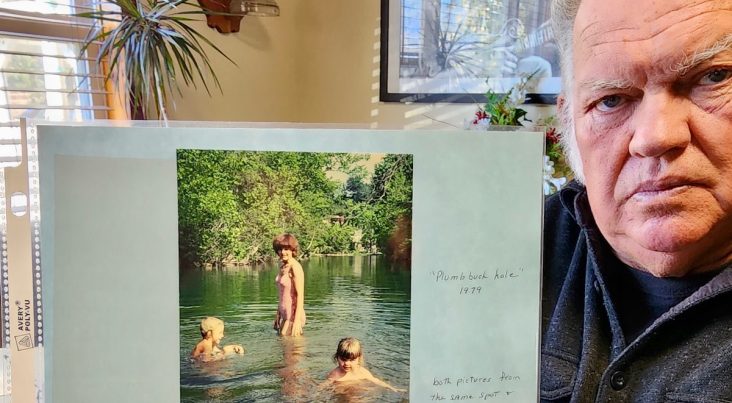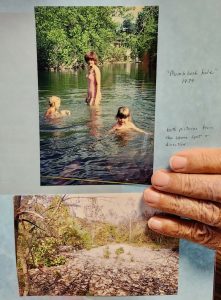The Buffalo: A river that has ‘really changed in places for the worse’
by November 27, 2023 5:36 pm 10,325 views

Paul Villines shows a picture of family swimming at what they called Plum Bush Hole on the Buffalo River. The spot is now dry.
Editor’s note: This is the second of two articles explaining the challenges of maintaining and preserving the more than 94,000 acres in the Buffalo National River system. Link here for the first story.
Paul Villines was born 76 years ago within a flagstone house by the Boxley Valley Mill Pond near the Buffalo River, and lived elsewhere only two years for military service during the Vietnam War. His mother was raised near the Mill Pond, and his father around Low Gap.
A wide swath of the land in the valley is owned by Villines and his family or is leased from the National Park Service (NPS) by him for raising cattle or cutting hay. He lived through the Buffalo’s designation as the nation’s first National River, the vigorous acquisition of private land by the National Park Service, and the reselling of much of the same property back to the families in the late 1980s and 1990s.
The bucolic Boxley Valley is one of seven areas within the Buffalo National River that the Park Service has further protected as a “Cultural Landscape,” with the aim of retaining old traditions and small family farms that give the valley its character.
Within the 8,000-acre valley, the Park protects 170 structures and features that embody Ozark culture in the 1800s – the hand-built fences and stone walls, the wells and cisterns, cemeteries, the log houses and outbuildings. The Park leases valley land to local farmers for pasture and producing hay, wheat and corn to retain the subsistence farming that settlers relied upon.
Villines maintains a thick white binder filled with photographs to remember the river through the decades. One shows his late wife Carol in 1979, with their daughter Jennifer and a nephew, enjoying what they informally call Plum Bush Hole at the river. A second photo in recent years captures the same swimming hole, but it’s bone dry.
“A lot of people come and go and don’t realize that the river has really, really changed in places for the worse. There’s lots of erosion. I’ve been concerned about it for a long time,” Villines said. “People who weren’t here years ago don’t have a clue how pretty it was. We had deep holes of water down to bedrock and fish, all kinds of wildlife. Now there are (virtually) no turtles, no mussels. This gravel is filling the water up, destroying the habitat, and the rich dirt along the creek bank is full of phosphorus.”
Landowners along the river can maintain their property but not the riverbank, and disagreements arise. The National Park Service wants to retain the land’s pastoral, agrarian character, but landowners argue the river is eating away at their land because they’re not allowed to maintain it.

“The farmers who used to live here, they wouldn’t have let this happen,” Villines said. Landowners maintained their gravel bars by regularly moving small amounts of gravel to opposite banks before obstructions formed.
“Erosion is natural, but a hurricane is natural and a tornado is natural. Managing them is natural,” he said.
Behind the Boxley Grist Mill, the river has cut and washed away more than 50 feet of bank, trees, and the soft, fertile soil, leaving jagged edges barren of vegetation that loom more than 10 feet above river level.
“Eventually it will undercut the Mill. It’s all written, basically; if you can read the river, you can see what’s going to happen.”
From his farmhouse in the valley, Villines sees a steady stream of cars pass on a Friday afternoon. He isn’t bothered by tourists. He’s more concerned about the health and longevity of the river itself.
The challenges and threats that the Buffalo River faces are detailed in a foundational document governing how the Park Service manages the river. The governing document was created in 2018 and is available online. Yet the Park Service lacks the funds and/or permission to address many of these challenges.
Erosion along the streambank is flagged within the document dozens of times. Other concerns are pollutants and external impacts to water and air quality from development, including municipal wastewater, septic systems, agriculture, vehicle exhaust, and coal-fired power plants. The river system also faces a lack of riparian buffers, increases in feral hog populations, which trample riparian vegetation, algae blooms and low dissolved oxygen impacting aquatic species and threatening the scenic character of the river, rising water temperatures, and widening river channels.
In a 2020 document, the Boxley Valley Comprehensive Area Plan, the NPS said any redirection of stream channels or riverbank stabilization would require extensive compliance with the Clean Water Act and NEPA, and “is best suited for a separate, targeted planning effort that considers the hydrology and flow pattern of the Buffalo River and how these correspond to current land uses.”
Concerns about these issues and the lack of funds to rectify them is part of what led the Runway Group to explore options for the river, including a controversial idea to redesignate the river system to a National Park Preserve. The Runway Group backed away from the idea when many residents and officials in the system area organized to oppose a redesignation.
“We believe a change in status is one idea that would provide needed infrastructure support to a growing number of tourists; would support the preservation of the river and its current boundaries; and would create new ways to benefit the surrounding communities,” noted part of a statement from the Runway Group.
National parks are funded by a variety of sources, including entrance fees (there is no fee for access to the Buffalo National River, only for use of a few campgrounds with amenities), concessions, Congressional appropriations, gifts and donations, and the Land and Water Conservation Fund.
